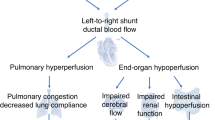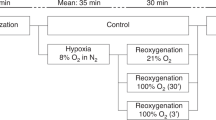Abstract
Objectives:
To identify demographic and clinical variables that relate to the postnatal increase in intestinal blood flow velocity in preterm infants.
Study design:
Fasting or preprandial peak systolic velocity (PSV) and time-averaged mean velocity (TAMV) in the superior mesenteric artery were measured once each day for the first 5 days of life. We investigated the relationship between blood flow velocity and the following variables: birth weight, gestational age, feeding volumes, number of days to reach full feeding volumes, type of feeding given, continuous positive airway pressure (CPAP) administration and hyperalimentation (HAL) administration.
Results:
Twenty-five infants with a mean birth weight of 1740 g and mean gestational age of 31.8 weeks were studied. There were significant increases in PSV (P<0.001) and TAMV (P=0.005) from postnatal day 1 to 5. The postnatal increase in TAMV and PSV was attenuated in infants administered CPAP or HAL for ⩾3 days; the results remained significant after controlling for birth weight and gestational age. There was a significant correlation (P<0.02) between volume of enteral feedings given on 2 of 5 days for TAMV, and on 1 of 5 days for PSV.
Conclusions:
These data support previous findings of significant increases in intestinal blood flow in preterm infants during the first week of life, and of inconsistent effects of enteral feeding volumes on fasting or preprandial intestinal blood flow. The reasons for, and the clinical implications of, attenuated increases in postnatal intestinal blood flow in infants on CPAP or HAL require further investigation.
This is a preview of subscription content, access via your institution
Access options
Subscribe to this journal
Receive 12 print issues and online access
$259.00 per year
only $21.58 per issue
Buy this article
- Purchase on Springer Link
- Instant access to full article PDF
Prices may be subject to local taxes which are calculated during checkout


Similar content being viewed by others
References
Reber KM, Nankervis CA, Nowicki PT . Newborn intestinal circulation. Physiology and pathophysiology. Clin Perinatol 2002; 29: 23–39.
Robel-Tillig E, Knupfer M, Pulzer F, Vogtmann C . Blood flow parameters of the superior mesenteric artery as an early predictor of intestinal dysmotility in preterm infants. Pediatr Radiol 2004.
Maruyama K, Koizumi T, Tomomasa T, Morikawa A . Intestinal blood-flow velocity in uncomplicated preterm infants during the early neonatal period. Pediatr Radiol 1999; 29: 472–477.
Fang S, Kempley ST, Gamsu HR . Prediction of early tolerance to enteral feeding in preterm infants by measurement of superior mesenteric artery blood flow velocity. Arch Dis Child Fetal Neonat Ed 2001; 85: F42–F45.
Matheson PJ, Wilson MA, Garrison RN . Regulation of intestinal blood flow. J Surg Res 2000; 93: 182–196.
Jacobson E . The splanchnic circulation. In: Johnson L (ed). Gastrointestinal Physiology. Mosby Year Book: St Louis, MO, 1991, pp 142–161.
Carver JD, Saste M, Sosa R, Zaritt J, Kuchan M, Barness LA . The effects of dietary nucleotides on intestinal blood flow in preterm infants. Pediatr Res 2002; 52: 425–429.
Leidig E . Doppler analysis of superior mesenteric artery blood flow in preterm infants. Arch Dis Child 1989; 64: 476–480.
Martinussen M, Brubakk AM, Vik T, Yao AC . Mesenteric blood flow velocity and its relation to transitional circulatory adaptation in appropriate for gestational age preterm infants. Pediatr Res 1996; 39: 275–280.
Yanowitz TD, Yao AC, Pettigrew KD, Werner JC, Oh W, Stonestreet BS . Postnatal hemodynamic changes in very-low-birthweight infants. J Appl Physiol 1999; 87: 370–380.
Van Bel F, Van Zoeren D, Schipper J, Guit GL, Baan J . Effect of indomethacin on superior mesenteric artery blood flow velocity in preterm infants. J Pediatr 1990; 116: 965–970.
Coombs RC, Morgan MEI, Durbin GM, Booth IW, McNeish ASl . Gut blood flow velocities in the newborn: effects of patent ductus arteriosus and parenteral indomethacin. Arch Dis Child 1990; 65: 1067–1071.
Hoecker C, Nelle M, Poeschl J, Beedgen B, Lindercamp O . Caffeine impairs cerebral and intestinal blood flow velocity in preterm infants. Pediatrie 2002; 109: 784–787.
Lane AJP, Coombs RC, Evans DH, Levin RJ . Effect of caffeine on neonatal splanchnic blood flow. Arch Dis Child Fetal Neonat Ed 1999; 80: F128–F129.
Van Bel F, Van Zwieten PHT, Guit GL, Schipper J . Superior mesenteric artery blood flow velocity and estimated volume flow: duplex Doppler US study of preterm and term neonates. Radiology 1990; 174: 165–169.
Maruyama K, Koizumi T . Superior mesenteric artery blood flow velocity in small for gestational age infants of very low birth weight during the early neonatal period. J Perinat Med 2001; 29: 64–70.
Coombs RC, Morgan MEI, Durbin GM, Booth IW, McNeish AS . Doppler assessment of human neonatal gut blood flow velocities: postnatal adaptation and response to feeds. J Pediatr Gastr Nutr 1992; 15: 6–12.
Coombs RC, Morgan MEI, Durbin GM, Booth IW, McNeish AS . Abnormal gut blood flow velocities in neonates at risk of necrotising enterocolitis. J Pediatr Gastr Nutr 1992; 15: 13–19.
Aly H, Milner JD, Patel K, El-Mohandes AA . Does the experience with the use of nasal continuous positive airway pressure improve over time in extremely low birth weight infants? Pediatrics 2004; 114: 697–702.
Meyer M, Mildenhall L, Wong M . Outcomes for infants weighing less than 1000 grams cared for with a nasal continuous positive airway pressure-based strategy. J Paediatr Child Health 2004; 40: 38–41.
De Paoli AG, Morley C, Davis PG . Nasal CPAP for neonates: what do we know in 2003? Arch Dis Child Fetal Neonat Ed 2003; 88: F168–F172.
Jaile JC, Levin T, Wung JT, Abramson SJ, Ruzal-Shapiro C, Berdon WE . Benign gaseous distension of the bowel in premature infants treated with nasal continuous airway pressure: a study of contributing factors. AJR Am J Roentgenol 1992; 158: 125–127.
Oste M, Van Ginneken CJ, Van Haver ER, Bjornvad CR, Thymann T, Sangild P . The intestinal trophic response to enteral food is reduced in parenterally fed preterm pigs and is associated with more nitrergic neurons. J Nutr 2005; 135: 2657–2663.
Nankervis CA, Reber KM, Nowicki PT . Age-dependent changes in the postnatal intestinal microcirculation. Microcirculation 2001; 8: 377–387.
Freeman-Ladd M, Cohen JB, Carver JD, Huhta JC . The hemodynamic effects of neonatal patent ductus arteriosus shunting on superior mesenteric artery blood flow. J Perinatol 2005; 25: 459–462.
Acknowledgements
We acknowledge the cardiology technicians, Patrick Johanboeke and Chris Madramootoo, who performed the ultrasound measurements for this study.
Author information
Authors and Affiliations
Corresponding author
Rights and permissions
About this article
Cite this article
Havranek, T., Thompson, Z. & Carver, J. Factors that influence mesenteric artery blood flow velocity in newborn preterm infants. J Perinatol 26, 493–497 (2006). https://doi.org/10.1038/sj.jp.7211551
Received:
Revised:
Accepted:
Published:
Issue Date:
DOI: https://doi.org/10.1038/sj.jp.7211551
Keywords
This article is cited by
-
Characterizing continuous positive airway pressure (CPAP) Belly Syndrome in preterm infants in the neonatal intensive care unit (NICU)
Journal of Perinatology (2024)
-
Real-time bowel ultrasound to characterize intestinal motility in the preterm neonate
Journal of Perinatology (2013)
-
Probiotics supplementation increases intestinal blood flow velocity in extremely low birth weight preterm infants
Journal of Perinatology (2013)
-
Correlation of abdominal rSO2 with superior mesenteric artery velocities in preterm infants
Journal of Perinatology (2013)
-
Regional tissue oxygenation in preterm born infants in association with echocardiographically significant patent ductus arteriosus
Journal of Perinatology (2011)



